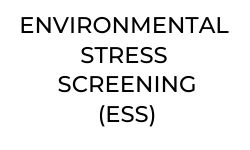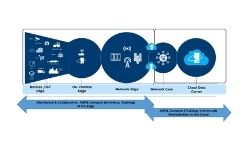Articles
Environmental Stress Screening

By ELDAAS
May 21, 2020
May 21, 2020
Environmental Stress Screening
Reduced Cost – Increased Profitability – Satisfied Customers
1. Objective:
Objective of this article is to summarize the concept of Environmental Stress Screening (ESS), its benefits, process and applicability for various stages in the manufacture of Electronic Equipment.
2. Environmental Stress Screening:
Environmental Stress Screening (ESS) is a means of screening electronic assembly’s at the most cost effective point of manufacture to expose defects that can’t be detected by visual inspection or electrical testing. These defects are typically related to defective parts or workmanship and are normally found as early field failures. ESS works by subjecting 100% of a group of products to an environmental stimulus or a set of stimuli for a predetermined time for the purpose of forcing failures to occur before shipment, in fact, at the board level. Failures are normal and expected when ESS is applied. This makes ESS radically different than more conventional certification testing which requires failure free operation as proof of reliability. ESS is not a test, it is a process.
Key factors for proper ESS implementation are:
- The stress environment must not exceed the electrical or mechanical limits of the product.
- An optimum level of stress must be applied to the product.
Expected benefits:
- Reduced field repair expense
- Fewer defects and waste
- Elimination of less effective screening procedures
- Lower unit cost
- Increased product value
- Improved customer satisfaction
- Better return on investment (ROI)
Test Flow Chart:
ESS may be conducted at any point in the manufacturing flow. It may be applied at more than one point, if justified. For electronic products, the three most common points are at the
- Component level
- Sub-assembly level (circuit card level) and
- Final assembly level.
Because the types of defects are different at each level, the stress conditions may be different at each level.
Following are the screening test will be carried out at different stages of product life cycle.
ESS is product-specific, since each product has its own set of potential defects, and since the applied ESS stresses affect each product differently. Even though the ESS process must be set up separately for each product, there are many common features of both products and stresses which cause many ESS processes to be similar.
The stresses applied in ESS are those which are expected to precipitate manufacturing defects. They are not necessarily those which the product will see in service. The two most common ESS stresses for electronic products are temperature cycling and vibration. They may be applied sequentially or simultaneously. ESS may be conducted anywhere in the manufacturing process flow.
Types of Failures Detectable By Thermal & Vibration Environments:
3. Test to Be Performed on PCBA & Module
| S.No. | Test Type | STD | Test Type | Defense Based Equipment’s Test Conditions | Naval Based Equipment’s Test Conditions | Remark |
|---|---|---|---|---|---|---|
| 1 | ESS- PCB Level | CemilacStd | Temperature Soaking | High Temperature Soaking: +85 degC for 24 Hrs (OFF State Passive Test) | Passive testing | |
| 2 | Thermal Shock | 0- 50 degree C, 60 min (for commercial grade components) -40 to 70 degree C, 60 min (for MIL components) Change over time- 03 Min No. of cycle-06 (IS 9000, DEF 133, MIL 810 & JSS 50101) | For PCBs -40°C……60 minutes +70°C……60 minutes Change over to take place within 03 minutes. Number of cycles 06. Note: Care to be taken while handling PCBs with ESD devices | Tests shall be performed in powered OFF state. After the temperature cycling, functionality test shall be carried out. | ||
| 3 | Vibration Test | Random Vibration 20-2000 Hz, Power density 0.02 gsq/Hz in at least two axis | Random Vibration: 20 – 2000Hz, 0.02g2/Hz in X, Y axes, for 10 minutes in each axis | Defence: Passive testing Navel: Active Testing | ||
| 4 | Endurance | 168 hrs at room temperature for sonars, communication equipment AIO systems, NAV aid equipment etc. and 08 hrs for radar equipment with 04 hrs ON | The equipment/ system is to be subjected to endurance test post FATS | |||
| 5 | Hemi sealing of PCBs | Conformal coating and Solder marking for all PCBs | ||||
| 1 | ESS-Module Level | MIL-STD-2164 | Burn In | 48 Hrs at 60 deg C (highest operating temperature) (ON State Active Test with functional performance monitoring every 3 / 6 Hrs) | Active testing | |
| 2 | Pre-Vibration Test | Pre Thermal (Initial) Vibration: 0.04g2/Hz for 5 minute in each of the 3 axes | Active testing | |||
| 3 | Thermal Cycle |
a) Temperature Range: (-) 30 deg C to (+)70 deg C b) No. of Test Cycles: 10 c) Dwell time: 3 Hours and 20 Minutes d) Rate of Temperature Change: 5 deg C per minute e) Total Test Duration: 33.5 Hours |
Active testing | |||
| 4 | Thermal Shock | For PCBs -40°C……60 minutes +70°C……60 minutes Change over to take place within 03 minutes. Number of cycles 06. Note: Care to be taken while handling PCBs with ESD devices | Active testing | |||
| 5 | Vibration Test | Random Vibration: 20 – 2000Hz, 0.02g2/Hz in X, Y axes, for 10 minutes in each axis in each axis | ||||
| 6 | Post-Vibration Test | Post Thermal (Final) Vibration: 0.04g2/Hz for 5 minute in each of the 3 axes | Active testing | |||
| 7 | Endurance | 168hrs at room temperature for sonars, communication equipment AIO systems, NAV aid equipment etc. and 08 hrs for radar equipment with 04 hrs ON | The equipment/ system is to be subjected to endurance test post FATS |
4. Summary:
ESS is a process to expose defective components and workmanship defects at the manufacturing stage and avoid their occurrence in early life of the product in the field. Though they look similar to environmental tests, they are not environmental tests which are carried out to bring out the defects due to design and engineering.
5. References:
- https://www.ijert.org/research/the-progressive-trends-in-design-reliability-and-maintainability-aspects-of-naval-defense-equipments-IJERTV3IS100781.pdf
- http://bharatshakti.in/wp-content/uploads/2015/10/JSS-55555-2000-Guidelines-for-Environmental-testing-at-CQAE-WE-Bangalore.pdf
- https://www.tutorialsweb.com/reliability/reliability5.4.htm
- http://dgaeroqa.gov.in/writereaddata/images/pdf/aqa-directive-2-jan-2015-qtp-atp.pdf
Read Our Articles

- By ELDAAS
- May 21, 2020
Objective of this article is to summarize the concept of Environmental Stress Screening (ESS), its benefits, process and applicability for various stages in the manufacture of Electronic Equipment. .. Read More



